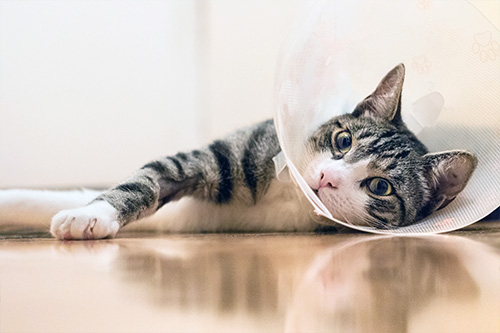
Spaying and neutering is the surgical sterilization of an animal. In other words, spaying and neutering ensure that your pet cannot reproduce. We recommend spaying or neutering at six months of age and after.
Benefits of Spaying Your Pet
The following are the benefits of spaying:
- Prevents unwanted pregnancy and the complications arising from pregnancy and delivery.
- Stops the heat cycle – you won’t have to listen to the sounds of your female in heat.
- Reduces the urge to roam. This makes it less likely that you will lose your pet, which in turn makes your pet less likely to contract a disease, get in a fight, get injured, or become a victim to cruelty, poison.
- Prevents the risk of diseases in the reproductive system, such as:
- Pyometra (infection in the uterus)
- Uterine Cancer
- Mammary tumour
- Cystic ovaries
Benefits of Neutering Your Pet
The following are the benefits of neutering your male pets:
- Contributing to reducing dog and cat overpopulation
- Lessens the urge to fight.
- In cats, neutering decreases spraying behaviour (marking of urine).
- Helping to prevent diseases such as:
-
- Prostate disease
- Testicular cancer
Several unwanted animals are being euthanized every day, simply because there are no homes for them. Even if your pet has a litter and you find homes for all of them, each of those pets takes a potential home away from other homeless pets waiting in a shelter. But aside from this responsibility, there are also significant health benefits for your pet.
WHAT DOES SPAYING OR NEUTERING INVOLVE?
Spaying involves surgical removal of both ovaries and the uterus in the female animals. Neutering involves surgical removal of both testicles in male animals. These surgeries are performed under general anesthetic with safety monitoring devices. If you are shopping around for a competitive price on these procedures, be sure to question the:
- If IV fluids are included or not
- Pain Medication used
- Type of anesthetic used
- Monitoring equipment used
- Procedures followed
At Summerlyn Pet Hospital, our experienced veterinary technicians continually assess your pet’s vital signs. The patients are monitored with a multi-functional monitor that measures the pulse, blood pressure, temperature, ECG, and pulse oximeter(SpO2 level). We also measure respiratory rate, heart rate and body temperature during all surgical procedures.
Although the risk of an anesthetic death in a normal healthy pet is very rare, our monitoring devices and procedures allow us to respond to an anesthetic emergency faster. Faster responses can save lives.
